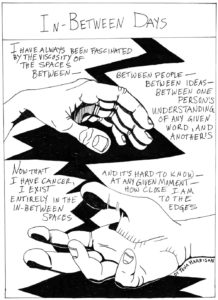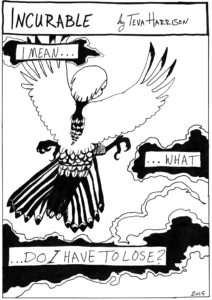 A cancer diagnosis affects everyone differently. Some people choose to spend the remaining years of their lives traveling. Some take up yoga, and some find comfort in music. Teva Harrison draws comics.
A cancer diagnosis affects everyone differently. Some people choose to spend the remaining years of their lives traveling. Some take up yoga, and some find comfort in music. Teva Harrison draws comics.
In her moving book, “In -Between Days: A Memoir About Living with Cancer,” Harrison gathers her drawings into a single, cohesive collection that is riddled with complex emotions. Each page contains a hand-drawn comic that documents Harrison’s experience living with cancer. Some of the comics are darkly humorous, poking fun at the absurdity of the healthcare system. Others are far more somber and raw, immersing readers in the fear and frustration that Harrison experiences. It’s a bittersweet collection of drawings and short stories that will leave you both warmed and heartbroken at once.
A Frightening Journey
After being diagnosed with stage IV metastatic breast cancer at 37 years old, Teva Harrison was left absolutely reeling. Watching her drawings evolve throughout the book, we see her navigate the confusion and chaos of those early days. Later, we see that chaos slowly settle — Harrison learns to rest in the murky unknown, unsure of what the future holds.

Credit: Teva Harrison
She calls this the “in-between space.” Harrison explains that she often feels as though she lives entirely in the dark cracks that exist between one edge and another. On one side is the hope for a life entirely free of cancer; on the other is death. Harrison survives the bewildering, unknown space in-between these two sides, embracing it and even learning to thrive within the uncertainty.
This metaphor crops up more than once throughout “In-Between Days.” It’s a truly stunning, original visual that anyone can relate to, especially those who have experienced it firsthand. Even if you’ve never had a serious illness, you can easily picture how it feels to occupy the shadowy spaces that Harrison describes. You can feel the existential fear, as well as the strange comfort that comes from living in those in-between spaces.
Although these spaces are a source of comfort for Harrison, there are still plenty of moments of frustration, which are among the grittiest moments in the book. We see Harrison remark on the universal apathy of cancer, and the disappointing results of tests and procedures.
Frustration and Hope
But by far one of the most disturbing aspects of the book is Harrison’s experiences navigating the healthcare system in the early days of her diagnosis. We watch as doctor after doctor ignores her increasingly alarming symptoms, brushing them off as perfectly ordinary ailments. This is a frustration that many people, especially women, can relate to. Many women feel as though their health complaints are not taken seriously, even when the symptoms are extremely painful.

Credit: Teva Harrison
Similarly, Harrison isn’t afraid to speak openly about the pressures put on women in the aftermath of a cancer diagnosis. She dives into how it feels knowing that she will never be able to have biological children of her own. She touches on the societal pressure that women still face to look put-together, even after learning they have a serious illness. And she discusses the unrealistic portrayal of breast cancer in mainstream media: It’s not always as curable as films and television show. Yet despite these frustrations, the theme of empowerment still shines through. She has moments of extreme pain and doubt, yet ultimately clings onto the beautiful moments in-between.
Teva Harrison’s strongest quality is that she accurately describes complex emotions without resorting to purple prose or long-winded explanations. Her drawings and writing are as sharp and precise as a shashimi knife. She knows exactly how to frame each comic in order to capture every emotion present in that moment, using only a few short sentences and simply-illustrated panels. As a result, her work packs far more emotional punch than it would if she were more wordy. She trusts that her audience will understand, and she never underestimates the power that these emotions have.
This is the best memoir I’ve ever read about how it feels to live with cancer. If you’re looking for a comprehensive, no-holds-barred look at cancer and mortality, then this is essential reading. I’ve never seen a writer capture this experience so fully and beautifully — a picture really does speak a thousand words.

 “In-Between Days: A Memoir About Living with Cancer” by Teva Harrison
“In-Between Days: A Memoir About Living with Cancer” by Teva Harrison


 Recovering Cremation Remains After the Los Angeles Fires
Recovering Cremation Remains After the Los Angeles Fires
 “As Tears Go By” by Marianne Faithfull
“As Tears Go By” by Marianne Faithfull















